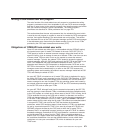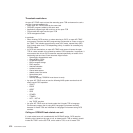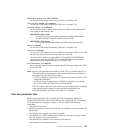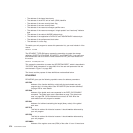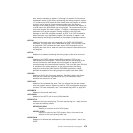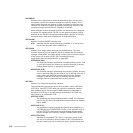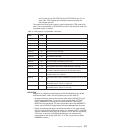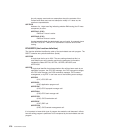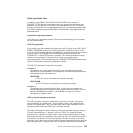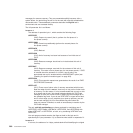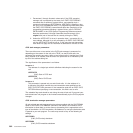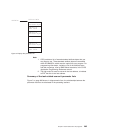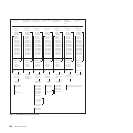Caller parameter lists
In addition to the DSECTs DFHUEPAR and DFHUERTR, the inclusion of
DFHUEXIT TYPE=RM in the task-related user exit program provides some field
definitions that are specific to the caller of the task-related user exit. The calling
program’s parameter list is normally addressed by R1 in the calling program’s RSA.
This RSA is addressed by field UEPHMSA of DFHUEPAR. These parameters are
described below.
Application program parameters:
If the caller is an application program, the format and addressing of its parameter
list are decided locally.
CICS SPI parameters:
If you enable your task-related exit program with the SPI option of the EXEC CICS
ENABLE PROGRAM command (or the program itself “expresses interest” in SPI
calls—see “The schedule flag word” on page 287), the exit program can be invoked
to satisfy EXEC CICS INQUIRE EXITPROGRAM commands on which the
CONNECTST or QUALIFIER option is specified. This allows applications to query
whether the exit program is connected to its resource manager, and its
entryname-qualifier. For information about the INQUIRE EXITPROGRAM command,
see the CICS System Programming Reference manual.
The CICS SPI parameter list contains two entries:
Parameter 1
The address of a 1-byte output field, which your task-related exit program
should use to indicate whether it is connected to its external resource manager.
The equated return code values are:
UERTCONN
(X'80') The exit is connected to its resource manager.
UERTNCONN
(X'40') The exit is not connected to its resource manager.
Parameter 2
The address of an 8-character output field, in which your task-related exit
program should return the qualifier of the external resource manager, if known.
See the UEPRMQUA parameter in “DFHUEPAR” on page 274 for more
information on qualifier names.
CICS syncpoint manager parameters:
The CICS syncpoint manager’s parameter list contains ten entries, although on
most invocations only parameters 1 and 10 contain values. The operation bytes
pointed to by parameters 1 and 10 contain flags which, when combined, form an
operation code that tells the TRUE why it has been invoked.
Parameters 2 through 9 contain values only when the syncpoint manager makes a
“Commit Unconditionally” or “Backout” call to the TRUE, for resynchronization
purposes after a session or system failure. These extra parameters point to fields
that identify the task, the transaction that started the task, the terminal from which it
was initiated, the identity of the terminal operator, the date and time of the failing
syncpoint, and (if there are no further units of recovery associated with the task) the
next transaction code. Typically, you would use these values to create meaningful
Chapter 2. Task-related user exit programs 279



